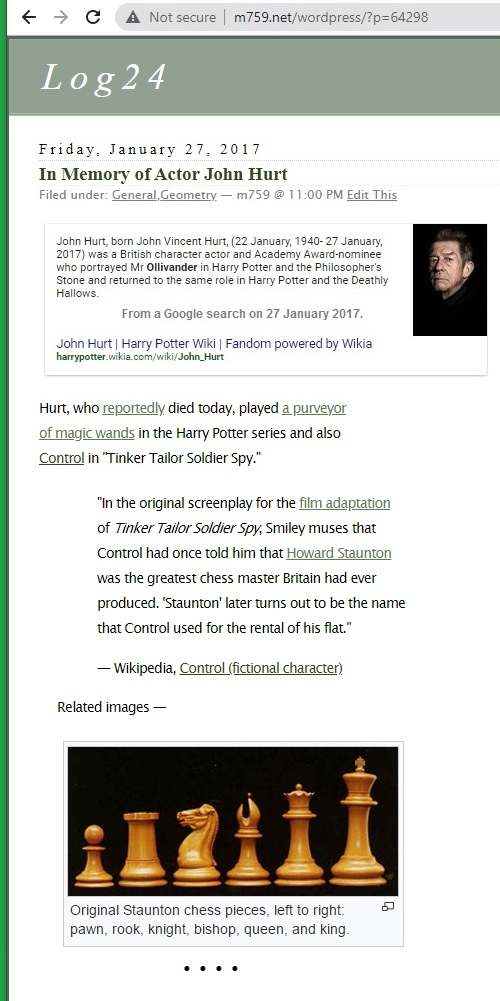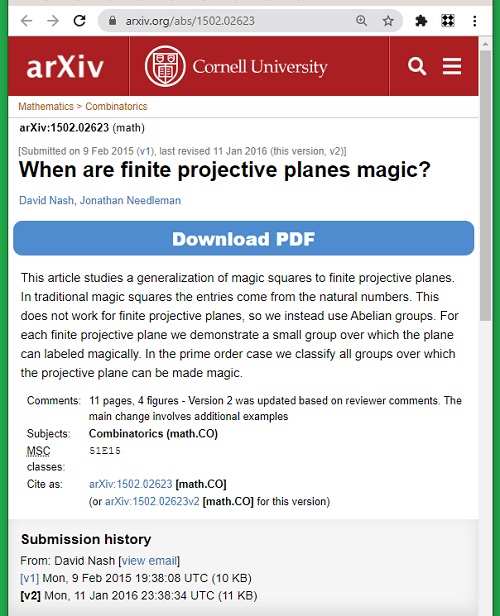Friday, April 5, 2024
Wednesday, March 27, 2024
“Manifest” as Magick Verb
From an Instagram ad today —

See also this meaning of "manifest" in Sphere —
novel by Michael Crichton, film by Barry Levinson.
Related material —
"Program or be programmed."
— A saying by the author of the above graphic novel.
Tuesday, March 19, 2024
Metadata: The Copenhagen Interpretation
of “Magic in the Moonlight”
of “Magic in the Moonlight”
Tuesday, February 6, 2024
Saturday, January 20, 2024
Needful Things: Faustus at the Magic Mountain
Image from a Sunday, January 7th, 2024, post now tagged "A Seventh Seal" —
Related image from a "Mathematics for Davos" post of
Thursday, January 18, 2024 —
Saturday, December 9, 2023
How Many Magic Beans, Jack?
Two notes from this journal on December 2, 2023 —
A flashback for The November Man —
As for " my own 'diamond theorem' " —
|
Question — "What is mathematician Steven H. Cullinane known for?" From the Copilot response (shorn of footnotes) — "Steven H. Cullinane is known for his work in finite geometry, particularly his Diamond Theorem. This theorem explains the surprising symmetry properties of some simple graphic designs, such as those found in quilts. It also provides a model for the 15 points, 35 lines, and 15 hyperplanes of the finite projective space PG (3,2). Cullinane’s work underlies the structure of the 35 square patterns in R. T. Curtis’s Miracle Octad Generator. His theorem has applications to sporadic simple groups, the connection between orthogonal Latin squares and projective spreads, and the symmetry of Walsh functions." |
Saturday, August 19, 2023
A Year for Magical Thinkers
See the posts of August 19, 2022.
Annals of Magical Thinking: The Shuttering
"Death Valley and Joshua Tree national parks announced campgrounds
closures from noon Saturday through at least Tuesday and preemptively
shuttered several roadways." — Los Angeles Times yesterday
Wednesday, June 21, 2023
Annals of Magical Thinking: The Rushmore Embedding
Monday, January 16, 2023
A Magic Mountain for McCarthy
From my RSS feeds last night —
This journal on Wednesday, December 28, 2022 —
For those who prefer a "liturgical, ecstatic style" —

Wednesday, December 21, 2022
The Unmagic Square
Last year on this date:
A Riddler Wannabe —
Related material — The Krauss passage quoted as above
by Shechtman in The New Yorker in December 2021 appears
also in a Log24 post of October 18, 2017: "Three Small Grids."
Wednesday, November 16, 2022
Wednesday, July 6, 2022
Magic Mikes of the Lost Cities
Monday, May 16, 2022
Sketch for a Magic Triangle

Updates from later the same day —
Related affine structures —
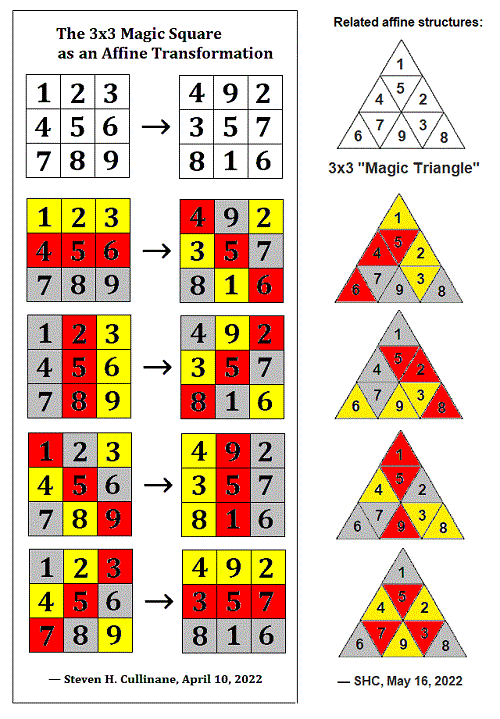
See also "Square+Triangles" in this journal.
The fishlike shapes within three of the above
ninefold colored triangles suggest some . . .
Related Entertainment —
Tuesday, December 14, 2021
Magical Mystical Writing on Glass
Mark Zuckerberg at Harvard, May 25, 2017 —
"No one writes math formulas on glass.
That’s not a thing."

Saturday, November 20, 2021
The Unmagicking
|
Unmagic Squares Consecutive positive integers:
1 2 3 Consecutive nonnegative integers:
0 1 2
Consecutive nonnegative integers
00 01 02
This last square may be viewed as
Note that the ninefold square so viewed
As does, similarly, the ancient Chinese
These squares are therefore equivalent under This method generalizes. — Steven H. Cullinane, Nov. 20, 2021 |
Tuesday, March 2, 2021
For Fans of Chaos Magic
The phrase “Chaos Magic” in the conclusion of last week’s
WandaVision episode suggests . . .
Friday, February 26, 2021
Non-Chaos Non-Magic
For fans of “WandaVision” —
“1978 was perhaps the seminal year in the origin of chaos magic. . . .”
— Wikipedia article on Chaos Magic
Non-Chaos Non-Magic from Halloween 1978 —
Related material —
A doctoral student of a different Peter Cameron —



( Not to be confused with The Tin Man’s Hat. )
Wednesday, January 20, 2021
The Magic Carpet Departs
Today's playlist at Joint Base Andrews —
ARRIVAL – "Gloria" and "Small Town Girl."
DEPARTURE – "YMCA" and "Tiny Dancer."
Related notes for film fans —

"Hannah Ware does the most she can in the role of Katia."

I prefer the less stressful TV series "GLOW,"
starring Alison Brie —

“In the bluish light emanating from the TV,
EE looked at him, her eyes veiled."
— Being There , by Jerzy Kosinski
Sunday, November 22, 2020
Saturday, August 22, 2020
Magic for Liars* . . .
From a web page —

From YouTube, for the Church of Synchronology —
Meanwhile, elsewhere . . .
* See that book title in this journal.
Wednesday, July 1, 2020
Friday, November 1, 2019
Rules of Magic
Tuesday, July 23, 2019
Word Magic
"Business-wise, Magic is working—Bloomberg reported
that the game brought in $500 million in revenue last year.
Hasbro owns Monopoly and Scrabble, but Magic is its top
game brand. . . .
The idea of using a card mechanic to generate story has
precedent—the Italian postmodern writer Italo Calvino
generated an entire novel based on drawing from a
tarot card deck. Games provide frameworks that miniaturize
and represent idealized realities; so do narratives."
— Adam Rogers, Sunday, July 21, 2019, at Wired

"The Esper party began . . ." —
|
Life of the Party From Stephen King's Dreamcatcher :
From Alfred Bester's The Demolished Man :
From Anne McCaffrey's To Ride Pegasus :
"… it's going to be accomplished in steps, this |
Adam Rogers at Wired as quoted above —
"The idea of using a card mechanic to generate story
has precedent. . . ."
See The Greater Trumps .
Friday, April 13, 2018
Monday, June 5, 2017
Magic in Mexico
Monday, January 16, 2017
The Magic Valley*
An alternative to Davos —
From a professor at Grand Valley —

* Title suggested by Thomas Mann's 1924 novel about Davos
Monday, July 18, 2016
ART WARS: Magic Circles
An artist mentioned in a NY Times obituary this morning —
(Click for the source.)
I prefer some not-so-magic circles —
Click for related posts tagged root circle.
Friday, May 22, 2015
Wednesday, February 18, 2015
Magical and Seductive
"I am trying to introduce a narrative,
something magical and seductive…."
— Oslo artist Josefine Lyche, translated
from the Norwegian by Google
Perhaps something like Arcade Fire or
Taylor Swift? (Click links for related posts.)
Friday, July 25, 2014
Magic for Jews
(Continued from April 8, 2013.)
See Two Blocks Short of a Design (May 5, 2011).
Magic in the Moonshine
“The yarns of seamen have a direct simplicity, the whole meaning
of which lies within the shell of a cracked nut. But Marlow was not
typical (if his propensity to spin yarns be excepted), and to him the
meaning of an episode was not inside like a kernel but outside,
enveloping the tale which brought it out only as a glow brings out a
haze, in the likeness of one of these misty halos that sometimes
are made visible by the spectral illumination of moonshine.”
— Joseph Conrad in Heart of Darkness
“By groping toward the light we are made to realize
how deep the darkness is around us.”
— Arthur Koestler, The Call Girls: A Tragi-Comedy,
Random House, 1973, page 118
“Spectral evidence is a form of evidence
based upon dreams and visions.” —Wikipedia
See also Moonshine (May 15, 2014) and, from the date of the above
New York Times item, two posts tagged Wunderkammer .
Related material: From the Spectrum program of the Mathematical
Association of America, some non-spectral evidence.
Thursday, July 24, 2014
Death in Mathmagic Land
Thursday, June 12, 2014
Magic
Wikipedia article on mathematician Herbert Wilf:
“One of Wilf’s former students is Richard Garfield,
the creator of the collectible card game
Magic: The Gathering .”
For more about Garfield, see yesterday’s post House of Cards.
Related material: This journal on the date of Wilf’s death—
See also 2/02, 2014.
Wednesday, May 14, 2014
Death in Mathmagic Land
"It was our old friend Pythagoras who discovered
that the pentagram was full of mathematics."
— Narrator, "Donald in Mathmagic Land," Disney, 1959
… and it was Peter J. Cameron who discovered that
mathematics was full of pentagrams.
From Log24 on May 3: Gray Space —
Robert J. Stewart (left) and a pentagram photo posted May 2
by Oslo artist Josefine Lyche. See also Lyche in this journal.
From Log24 on May 13: An Artist's Memorial —
The death mentioned in the above May 13 post occurred on
May 12, the date of a scheduled Black Mass at Harvard.
Related material:


Monday, April 8, 2013
Magic for Jews
A commenter on Saturday's "Seize the Dia" has
suggested a look at the work of one Mark Collins.
Here is such a look (click to enlarge):
I find attempts to associate pure mathematics with the words
"magic" or "mystic" rather nauseating. (H. F. Baker's work
on Pascal's mystic hexagram is no exception; Baker was
stuck with Pascal's obnoxious adjective, but had no truck
with any mystic aspects of the hexagram.)
The remarks above by Clifford Pickover on Collins, Dürer, and
binary representations may interest some non-mathematicians,
who should not be encouraged to waste their time on this topic.
For the mathematics underlying the binary representation of
Dürer's square, see, for instance, my 1984 article "Binary
Coordinate Systems."
Those without the background to understand that article
may enjoy, instead of Pickover's abortive attempts above at
mathematical vulgarization, his impressively awful 2009 novel
Jews in Hyperspace .
Pickover's 2002 book on magic squares was, unfortunately,
published by the formerly reputable Princeton University Press.
Related material from today's Daily Princetonian :
See also Nash + Princeton in this journal.
Thursday, December 6, 2012
Magic Square
This post was suggested by the December 4th death
of modernist composer Jonathan Harvey, 73,
and by Harvey's reflections on his 2007 opera
Wagner Dream .
For related reflections, see the Oct. 10 post on
the Dürer magic square in Mann's Doctor Faustus .
See also a December 2nd post on the Nov. 18 death of
chess grandmaster Elena Akhmilovskaya Donaldson.

Thursday, July 28, 2011
Magical Realism Revisited
The magical part— Synchronicity—
See Roger Cohen in this journal on January 15, 2009 and, on the
same date, Jesse Jarnow on Bob Dylan in The Jewish Daily Forward .
The realism part— Cohen's "smart power" and IQ tests involving pattern blocks.
The above quilt pattern software (both versions) is by Jarnow's father Al.
For a realistic approach to such patterns, see Blockheads in this journal.
Friday, July 15, 2011
The Magic of Numbers*
NY Lottery this afternoon:

See Post 757— "Release Date"— and The-Numbers.com
on a film with the release date 7/3/85.
* Title of a course at Harvard. See (for instance)
the Harvard page on The Numerology of the Beast—
"Now in math the magic is not in special numbers
like 7 or 28, but in the fabric of number systems…."
Sure it is.
Thursday, June 23, 2011
Script Magic…
In a Jewish Cathedral
From The New York Times Magazine of Sunday, April 6, 1986—
"David Rayfiel's Script Magic" by Alex Ward
WHEN THE CALL came last year to revise ''The Morning After,'' Rayfiel was working on a screenplay about the 1911 Triangle Shirtwaist Company fire for Barbra Streisand and Jane Fonda. He has now resumed work— as the principal writer, not the reviser— on that script. But chances are good that he will have further interruptions. Pollack will probably call and say, as he usually does, ''David, I need access to your brain.'' And Rayfiel will probably say, as he usually does, ''That's O.K., I'm not using it.'' He will revise another script, and be reluctant about taking credit for it.
''I guess it's like the medieval stonecutters who worked on the cathedrals,'' he says. ''There's all that elaborate work. The saints were carved by one guy, the cherubs by someone else. They didn't care about getting credit, they knew what they'd done. I'm like that. I'm the guy who does the cherubs.''
Related material:
Proginoskes in this journal and Abracadabra from the midnight of June 18-19.
See also Rayfiel's obituary in today"s Times .
For some quite different work, also from April 1986, see—
Thursday, May 5, 2011
On Art and Magic
Two Blocks Short of a Design:
A sequel to this morning’s post on Douglas Hofstadter

Photo of Hofstadter by Mike McGrath taken May 13, 2006 |
Related material — See Lyche’s “Theme and Variations” in this journal
and Hofstadter’s “Variations on a Theme as the Essence of Imagination”
— Scientific American October 1982
A quotation from a 1985 book by Hofstadter—
“… we need to entice people with the beauties of clarity, simplicity, precision,
elegance, balance, symmetry, and so on.
Those artistic qualities… are the things that I have tried to explore and even
to celebrate in Metamagical Themas . (It is not for nothing that the word
‘magic’ appears inside the title!)”
The artistic qualities Hofstadter lists are best sought in mathematics, not in magic.
An example from Wikipedia —
|
Mathematics
The Fano plane block design |
Magic
The Deathly Hallows symbol— |
Thursday, October 14, 2010
Diamond Theory and Magic Squares
"A world of made
is not a world of born— pity poor flesh
and trees, poor stars and stones, but never this
fine specimen of hypermagical
ultraomnipotence."
— e. e. cummings, 1944
For one such specimen, see The Matrix of Abraham—
a 5×5 square that is hypermagical… indeed, diabolical.
Related material on the algebra and geometry underlying some smaller structures
that have also, unfortunately, become associated with the word "magic"—
- Finite Geometry of the Square and Cube
- Clifford Pickover on a 4×4 square
-
Christopher J. Henrich on the geometry of 4×4 magic squares
(without any mention of [1] above or related work dating back to 1976)
" … listen: there's a hell
of a good universe next door; let's go"
— e. e. cummings
Happy birthday, e. e.
Sunday, March 31, 2024
Blue
From this journal on October 15, 2023 —
|
"Can you make it any more complicated?" |
One approach . . .
Saturday, March 23, 2024
Wednesday, January 31, 2024
Family Values for Phil and Lily Collins
"Yes, you'll be goin' loco
down in Acapulco,
the magic down there
is so strong."
This song is from the 1988 film "Buster."
(Wikipedia: "Buster is a 1988 British
romantic crime comedy-drama
based on events from the Great Train Robbery,
starring Phil Collins….")
For a related religious use of that name —
"Look, Buster, do you want to live?" —
see Fritz Leiber's "Damnation Morning."
Yesterday, January 30, 2024, was Phil Collins's birthday.
Friday, January 26, 2024
For London Werewolves: Steppenwolf and the Moon Knights
Thursday, December 28, 2023
Basque Country Art Book
Book description at Amazon.com, translated by Google —
|
Las matemáticas como herramienta
Mathematics as a tool by Raúl Ibáñez Torres Kindle edition in Spanish, 2023 Although the relationship between mathematics and art can be traced back to ancient times, mainly in geometric and technical aspects, it is with the arrival of the avant-garde and abstract art at the beginning of the 20th century that mathematics takes on greater and different relevance: as a source of inspiration and as a tool for artistic creation. Let us think, for example, of the importance of the fourth dimension for avant-garde movements or, starting with Kandisnky and later Max Bill and concrete art, the vindication of mathematical thinking in artistic creation. An idea that would have a fundamental influence on currents such as constructivism, minimalism, the fluxus movement, conceptual art, systematic art or optical art, among others. Following this approach, this book analyzes, through a variety of examples and activities, how mathematics is present in contemporary art as a creative tool. And it does so through five branches and the study of some of its mathematical topics: geometry (the Pythagorean theorem), topology (the Moebius strip), algebra (algebraic groups and matrices), combinatorics (permutations and combinations) and recreational mathematics (magic and Latin squares). |
From the book ("Cullinane Diamond Theorem" heading and picture of
book's cover added) —
Publisher: Los Libros de La Catarata (October 24, 2023)
Author: Raúl Ibáñez Torres, customarily known as Raúl Ibáñez
(Ibáñez does not mention Cullinane as the author of the above theorem
in his book (except indirectly, quoting Josefine Lyche), but he did credit
him fully in an earlier article, "The Truchet Tiles and the Diamond Puzzle"
(translation by Google).)
About Ibáñez (translated from Amazon.com by Google):
Mathematician, professor of Geometry at the University of the Basque Country
and scientific disseminator. He is part of the Chair of Scientific Culture of the
UPV/EHU and its blog Cuaderno de Cultura Cientifica. He has been a scriptwriter
and presenter of the program “Una de Mates” on the television program Órbita Laika.
He has collaborated since 2005 on the programs Graffiti and La mechanica del caracol
on Radio Euskadi. He has also been a collaborator and co-writer of the documentary
Hilos de tiempo (2020) about the artist Esther Ferrer. For 20 years he directed the
DivulgaMAT portal, Virtual Center for the Dissemination of Mathematics, and was a
member of the dissemination commission of the Royal Spanish Mathematical Society.
Author of several books, including The Secrets of Multiplication (2019) and
The Great Family of Numbers (2021), in the collection Miradas Matemáticas (Catarata).
He has received the V José María Savirón Prize for Scientific Dissemination
(national modality, 2010) and the COSCE Prize for the Dissemination of Science (2011).
Saturday, October 28, 2023
Sunday, October 15, 2023
A Red Dot in Memory of Candida Royalle*
For another version of the helpful
video-positioning tongue icon, see
https://marcelanowak.com/port/harmonious-resonance/ .

* See tonight's previous post.
Friday, September 29, 2023
36 Shades of Blue: Namespace Mastery and Subjection
Tom McCarthy today on a new novel about von Neumann at Los Alamos:
|
"Beyond its mid-20th-century viewfinder, though, it quickly becomes clear that what The Maniac is really trying to get a lock on is our current age of digital-informational mastery and subjection." "Amid — or, more aptly, beneath — the panoply of brilliant men in The Maniac , women function as bit players. At Los Alamos they’re even called 'computers,' since they carry out the secondary, workaday calculations that are then fed upward for male geniuses to work their magic on. But does von Neumann really deserve the title 'Father of Computers,' granted him here by his first wife, Mariette Kovesi? Doesn’t Ada Lovelace have a prior claim as their mother?" |

Wednesday, September 27, 2023
The Redford Dogma
Friday, September 8, 2023
Life Coaches
Lilydale and Rain , by Like No. 90 (Rain is the one on the left) —
A perhaps more useful coach . . .
Some prose by Harrington —
| By 1956, Fromm was dining at Suzuki’s part-time home in New York City, and talking with him about ways in which Zen could contribute to a wholesale reimagining of psychoanalytic therapeutics and theory (see Friedman and Schreiber 2013). By this time, also, Fromm was himself spending considerable periods of time at a new home in Cuernavaca, Mexico. At one point he suggested that Suzuki consider moving in with him permanently. When Suzuki politely declined, Fromm conceived instead a major conference based in Mexico that would try to take stock of the entire current state of the conversation between Zen and psychotherapy (see Friedman and Schreiber 2013). In 1957, some fifty psychotherapists—double the original expected number—participated in a week of presentations and discussions. Fromm later recalled the event as a magical time: what began as a traditional conference with the usual ‘over-emphasis on thoughts and words' changed over a few days, as people 'became more concentrated and more quiet.' |
See as well a web page on what is now called "shadow work" —
an activity completely different from the "shadow work" described
some years ago by Ivan Illich, the so-called "Prophet of Cuernavaca."
Friday, August 25, 2023
Windows Programming
Sunday, July 16, 2023
D-Day Science Death
A New York Times obituary yesterday reported the
June 6 death, at 91, of a Harvard professor who dealt with
the relations between science and society —
“ 'Everett was one of a new generation of social historians
of science who insisted that it was not enough to pay attention
to the internal intellectual story of science,' Anne Harrington,
the Franklin L. Ford professor of the history of science at Harvard,
said by email. 'The field needed to attend also to how science was
shaped by and also helped shape the conditions of the social world.' ”
Consider as well Scarlett Johansson on Alan Watts in "Her" (2013)
and Harrington on intellectual history in Cuernavaca . . .
| By 1956, Fromm was dining at Suzuki’s part-time home in New York City, and talking with him about ways in which Zen could contribute to a wholesale reimagining of psychoanalytic therapeutics and theory (see Friedman and Schreiber 2013). By this time, also, Fromm was himself spending considerable periods of time at a new home in Cuernavaca, Mexico. At one point he suggested that Suzuki consider moving in with him permanently. When Suzuki politely declined, Fromm conceived instead a major conference based in Mexico that would try to take stock of the entire current state of the conversation between Zen and psychotherapy (see Friedman and Schreiber 2013). In 1957, some fifty psychotherapists—double the original expected number—participated in a week of presentations and discussions. Fromm later recalled the event as a magical time: what began as a traditional conference with the usual ‘over-emphasis on thoughts and words' changed over a few days, as people 'became more concentrated and more quiet.' |
A search in this journal for D-Day related material yields
posts tagged "Shadow Hacking."
"Please wait as your operating system is initiated."
Monday, June 19, 2023
New Career Paths
"Experience the magic of Mexico." — Delta vacations ad.
See also Midnight in the Garden (March 15, 2011)
and New Day Nina (September 22, 2011).
Wednesday, June 7, 2023
Exploring Color Space . . . Continues.

"Another story" —
See also Sontag's own account of the Mann meeting.
Related material —

It would seem that Moser is deeply confused about two different
meetings of Sontag with Mann — discussing Doctor Faustus
in 1947, and, later, as a U. of Chicago student, discussing
The Magic Mountain with Mann in 1949 on the Feast of the
Holy Innocents — coincidentally, also the date of her dies natalis
(in the Catholic sense) in 2004.
Monday, June 5, 2023
Vienna Requiem
"You put the lime in the coconut . . ."
Art is magic delivered from
the lie of being truth.
— Theodor Adorno, Minima moralia,
London, New Left Books, 1974, p. 222
(First published in German in 1951.)
The director, Carol Reed, makes…
impeccable use of the beauty of black….
— V. B. Daniel on The Third Man
I see your ironical smile.
— Hans Reichenbach
Adorno, The Third Man, and Reichenbach
are illustrated below (l. to r.) above the names of
cities with which they are associated.

Friday, June 2, 2023
Reichenbach’s Fell Swoop
See The Eightfold Cube and . . .
Art is magic delivered from
the lie of being truth.
— Theodor Adorno, Minima moralia,
London, New Left Books, 1974, p. 222
(First published in German in 1951.)
The director, Carol Reed, makes…
impeccable use of the beauty of black….
— V. B. Daniel on The Third Man
I see your ironical smile.
— Hans Reichenbach
Adorno, The Third Man, and Reichenbach
are illustrated below (l. to r.) above the names of
cities with which they are associated.

Wednesday, May 31, 2023
Tuesday, May 30, 2023
The Tour
In memory of a co-founder of Hollywood's "Magic Castle"
who reportedly died at 92 on Sunday . . .
From posts that were tagged "Blake Tour" on Sunday —
Sunday, May 21, 2023
Ingathering
The reference to "Magic: The Gathering" in the previous post
suggests a review of "gathering" tales that I personally prefer —
Putting the “Art” in “Artificial”
"So far, AIs produce abstract, almost surreal ideas, that
may lead you somewhere but have no consistent purpose."
— Greg Rutkowski, quoted on May 8, 2023, as below:
Source Code —
<title>What can be done to stop generative AI art? | Creative Bloq</title>
<meta name="pub_date" content="2023-05-08T07:30:27+00:00">
<meta name="description" content="These professional artists are
fighting back against generative AI art.">
<link rel="canonical" href="https://www.creativebloq.com/features/
what-can-stop-generative-ai-art">
What if the AIs are named Tara Hernandez and Damon Lindelof?
Yesterday's "Electric Avenue" post suggests an image by Rutkowski
from "Magic: The Gathering" . . .

Wednesday, May 3, 2023
Art Lesson for Doktor Faustus
Exercise: Show that Dürer's 1514 "magic" square is an affine automorphism.
For a solution, see other posts now tagged Affine Squares.
Tuesday, April 25, 2023
Bedknobs and Broomsticks
"Bedknobs and Broomsticks is a 1971 American musical fantasy film
directed by Robert Stevenson and produced by Bill Walsh for
Walt Disney Productions. It is loosely based upon the books
The Magic Bedknob; or, How to Become a Witch in Ten Easy Lessons
(1944) and Bonfires and Broomsticks (1947) by English children's author
Mary Norton."

Glow with the Flow

Friday, April 14, 2023
Sunday, January 22, 2023
“Preform an affine transformation”
Saturday, January 21, 2023
Dead-Poet Witcraft
"Death is the mother of beauty." — Wallace Stevens
From the 2020 Feast of St. Wallace Stevens,
who reportedly died in 1955 on August 2 —
Related material —
Exercise: Can each order-4 magic square be obtained by some
transformation like the one above (i.e., preserving affine hyperplanes)?
If not, why not?
Update of 31 Jan. 2023 — Spoiler: Remarks by Tilman Piesk.
Sunday, January 15, 2023
A Date for Thing
Monday, November 7, 2022
Prescott Street Revisited: The Boys in the Kitchen
Or: MDT-48 Meets COMP360.
‘It doesn’t have a street-name and that’s because, as yet,
it doesn’t have any street profile – which is incidentally
the way we want it to stay. The boys in the kitchen are
keeping it low-key and anonymous. They’re calling it MDT-48.’
The boys in the kitchen?
— Glynn, Alan. Limitless: A Novel (p. 40).
Picador. Kindle Edition.
(Originally published by Little, Brown
in Great Britain in 2001 as The Dark Fields .)
From Log24 on Nov. 29, 2020 —
CNN story from All Souls' Day 2022 —
“This drug can be extracted from magic mushrooms,
but that is not the way our compound is generated.
It’s synthesized in a purely chemical process
to produce a crystalline form,” said Goodwin, who is
the chief medical officer of COMPASS Pathways,
the company that manufactures COMP360 and
conducted the study."
See as well "To Think That It Happened on Prescott Street"
and related posts.
Tuesday, November 1, 2022
Friday, October 7, 2022
Saturday, September 10, 2022
Solomon’s Mental Health Month
May 2003 was "Solomon's Mental Health Month" in this journal.
An essay linked to on the 9th of May in that month —
|
"Taking the Veil," by Jessica Kardon
https://web.archive.org/web/20021102182519/ James Hillman, writing in The Soul's Code, argues for his "acorn theory" of human individual identity, and suggests that "each person bears a uniqueness that asks to be lived and that is already present before it can be lived." He insists we are born with a given character, a daimon, the carrier of destiny. This theory is closely linked to the beautiful myth described by Plato in his Republic, when the soul stands before Lachesis and receives his specific soul guardian. Hillman maintains that the daimon will always emerge somehow, even if thwarted or unrecognized. I never had ambitions that reached fruition in the adult world. I have had only two career interests in my life – both formed precognitively. I wanted to be a mermaid or a nun. By the time I learned – shockingly late – that I could not be a mermaid, I had realized I would not be a nun. I concur with Hillman's emphasis on the persistence of early disposition, and I like to imagine that my dreamy, watery, Victorian and self-righteous psyche has held aspects of both of these early interests, throughout my life. I was adopted one month after my birth. I was tended by nuns during the first four weeks of my life. Thereafter, I spent my whole educational life in convent schools. It was the sisters of Saint Vincent de Paul that gave me my favorite musical and my early distortions about romantic love and the gender plans of Our Lord. My misconceptions about love and marriage were culled from the Lerner Loewe musical Gigi, a wonderful film based loosely on a Colette novel. I was summoned along with my whole class to the gymnasium to view the movie under the edgy eye of Sister Bernadette. Sister Bernadette was a large, mesomorphic nun famed for the beatings she gave to boys and girls alike, and feared for the mean zest with which she bestowed her favors upon many of us. I was not beaten – but once, believing I was wearing lipstick, she held my head in a sink and scrubbed my lips until they bled, then slapped me. I recall this with a mild, rueful whimsy. We were all manhandled. In memory, Bernadette seems more like an angry and troubled older sibling than a true figure of authority. Anyway, I loved Gigi. It fed directly into my Francophilia. I was convinced that at some future date, I, like Gigi, would be trained as a courtesan. I, too, would cause some hard case, experienced roué to abandon his chill and irony. I saw myself strolling down the Champs Elysee with Louis Jordan in rapt attendance, pushing a baby carriage, wearing a hat the size of a manhole cover, hoisting a parasol above that to assure the longevity of my adorable pallor. The gender plans of Our Lord had recently been revealed to me too. Sister B. had drawn a ladder on the blackboard, a ladder with three rungs. At the top, she explained, were the priests, the nuns, and the monks. These souls had surrendered their lives to God. All would be taken directly to heaven upon their passing from this vale of tears, as we all referred to the world in those lean emotional times. On the middle rung stood the married. If you married and kept the law – which meant leaving every act of marital congress open to the reception of a child, you would be eligible for heaven. If you were foul in marriage, seeking your pleasure, you were going to be damned. On the bottom rung were those selfish souls who had remained single and had imagined their lives their own. This group had never given themselves to Our Lord. They were headed to hell in a sort of preternatural laundry chute. So we little ladies had two viable options: marry and breed without ceasing – or take the veil. Despite my hat and perambulator fantasies, once given the sorry news of the ladder, the veil became the clear romantic favorite. Therefore I began my research. I obtained a catalogue of nunnery. It offered photographs of each order, describing the duties of the specific order, and displaying the garb of that order. I was looking for two things – a great looking veil and gown, and a contemplative order. I had no desire to sully my glorious vision of myself with a life in the outer world. It was apparent to me that the teaching of children was going to involve a whole range of miseries – making them cry, telling them the bad news about the ladder, and so forth. This was not for me. I saw myself kneeling on the floor of my pristine little cell, serene and untouched by human hands. Teaching would be certain to interfere with the proper lighting. Yoked to a bunch of messy children, I could not possibly have the opalescent illumination of heaven falling reliably on my upturned visage. What divided me from my dream of rebirth as a mermaid was the force of what was real: I could not morph. What divided me from my dream of life as a nun was the force of the erotic: I would not abstain. Now, long years later, I am still underwater, and I am still bending the knee. I live in the blue shadows of hidden grottoes, and I am swimming, too, in the gold of my drifting prayers. September 7th, this dream. I am standing in a dimly lit room, gazing at a group of heavy, antique silk burqas that look weirdly like Fortuny gowns. A holy woman approaches me, and tells me that my soul will leave my body, and enter these garments. She turns and points at a young girl standing nearby, a child with close-cropped hair and a solemn look. My heart knows her, but my eyes don't. For a moment I am thinking, exactly as I did in the seventies when holding a joint: "This isn't working." Suddenly, these things: I feel the shape of flame, then I am the shape. I am released into the air, and as pure essence I enter other forms, dissolving in them, gathering my energy back into myself, and flying out again. This was a sensation so exquisite that my dreaming brain woke up and announced to me: "This is a dream about death." I saw that child again as I flew. This time my eyes knew her. I flew to her, but the flame of my soul would not cohere with hers, this child who was, of course, my own self. In the shadows alone, I heard myself whisper: "I'm in the wind. I'm in the water." This lovely dream, which gave me the sublime gift of a little visceral preview of the soul in the death process, also showed me my guardian spirit; divided, but viable. I pass through my life swimming in one self, kneeling in the other. I thought of Rilke's 29th Sonnet to Orpheus and realized this was what I had been dreaming about all my life, moving between them.
by jessica kardon |
See as well yesterday's post "At a Still Point."
Orthogonal Latin Triangles
From a 1964 recreational-mathematics essay —
Note that the first two triangle-dissections above are analogous to
mutually orthogonal Latin squares . This implies a connection to
affine transformations within Galois geometry. See triangle graphics
in this journal.

Update of 4:40 AM ET —
Other mystical figures —
"Before time began, there was the Cube."
— Optimus Prime in "Transformers" (Paramount, 2007)
Monday, August 1, 2022
Enowning
Related material — The Eightfold Cube.
See also . . .
"… Mathematics may be art, but to the general public it is
a black art, more akin to magic and mystery. This presents
a constant challenge to the mathematical community: to
explain how art fits into our subject and what we mean by beauty."
— Sir Michael Atiyah, “The Art of Mathematics”
in the AMS Notices , January 2010
Sunday, July 24, 2022
The Manifestation Manifesto
Some may prefer their own, less collective, manifestations.
Magic Mikes Continues:

"I get no kick from champagne…." — Cole Porter

See too another item with the BRC "Waking Dreams" date —
Monday, June 27, 2022
The Plotlines
"Westworld Season 4 begins at Hoover Dam, with William
looking to buy the famous landmark. What does he consider
to be 'stolen' data that is inside?"

For further details, see Log24 on May 16,
Sketch for a Magic Triangle.
Wednesday, June 22, 2022
Occupy Space Continues.
Alternate Title —
Types of Ambiguity:
The Circle in the Triangle,
the Singer in the Song.
From an excellent June 17 Wall Street Journal review of a new
Isaac Bashevis Singer book from Princeton University Press —
" 'Old Truths and New Clichés,' a collection of 19
prose articles, most appearing in English for the
first time, reveals that Singer was as consummate
an essayist as he was a teller of tales." — Benjamin Balint
From a search in this journal for Singer —
Related material —
From a post of June 2, "Self-Enclosing" —
|
"… the self-enclosing processes by which late 20th-century
— Colin Burrow in the June 9, 2022 issue |
From the December 14, 2021, post Notes on Lines —

The triangle, a percussion instrument that was
featured prominently in the Tom Stoppard play
"Every Good Boy Deserves Favour."
Tuesday, June 14, 2022
A Triangle of Sadness
The title refers to this year's
Cannes Film Festival winner.
Related material:
From a post of June 2, "Self-Enclosing" —
|
"… the self-enclosing processes by which late 20th-century
— Colin Burrow in the June 9, 2022 issue |
From a post of June 13, "The Theater Game" —
From a post of June 12, "Triangle.graphics, 2012-2022" —
Der Einsatz . . . Continues.
Katherine Neville, author of The Eight —
"Nine is a very powerful Nordic number."
in The Magic Circle , Ballantine paperback, 1999, p. 339.
Sunday, June 12, 2022
Monday, June 6, 2022
Screenwriters on LA
|
"Living in Los Angeles is living in the cradle of the industry I fantasized about being a part of since my father gifted me his Sears Super-8 movie camera when I was seven years old. Hollywood is a city but it is also a mythology. A magical fantasy. A living dream. And yes, a dream is a mere sigh away from becoming a nightmare. Many tears have been shed around this town. They’ve been watering the soil for generations, adding more lush green to this transient desert mirage. As Nathanael West wrote in his ode to those on the fringes of Hollywood in his 1939 novel, The Day of the Locust , ‘Only those who still have hope can benefit from tears.' " — Adam Rifkin, quoted on Jan. 25, 2022 |
See related remarks from a different author in a Log24 search
for a John O'Hara title, "Hope of Heaven."
Saturday, June 4, 2022
Sunday, May 29, 2022
Lost in Deep Space Translation
"Black art" → "Black magic"
|
https://www.latimes.com/obituaries/story/2022-05-28/
Keasha Dumas Heath, executive director at
Keasha Dumas Health, executive supervisor at |
Consider the source.

Thursday, May 26, 2022
Tuesday, May 24, 2022
Playing the Palace
From a Jamestown (NY) Post-Journal article yesterday on
"the sold-out 10,000 Maniacs 40th anniversary concert at
The Reg Lenna Center Saturday" —
" 'The theater has a special place in our hearts. It’s played
a big part in my life,' Gustafson said.
Before being known as The Reg Lenna Center for The Arts,
it was formerly known as The Palace Theater. He recalled
watching movies there as a child…."
This, and the band's name, suggest some memories perhaps
better suited to the cinematic philosophy behind "Plan 9 from
Outer Space."

"With the Tablet of Ahkmenrah and the Cube of Rubik,
my power will know no bounds!"
— Kahmunrah in a novelization of Night at the Museum:
Battle of the Smithsonian , Barron's Educational Series
The above 3×3 Tablet of Ahkmenrah image comes from
a Log24 search for the finite (i.e., Galois) field GF(3) that
was, in turn, suggested by last night's post "Making Space."
See as well a mysterious document from a website in Slovenia
that mentions a 3×3 array "relating to nine halls of a mythical
palace where rites were performed in the 1st century AD" —
Sunday, May 22, 2022
Wednesday, May 18, 2022
“The form, the pattern”
An image from Slovenia missed earlier* in the search above —
"Et cetera, et cetera, et cetera." — Oscar Hammerstein
* See "Robin Wilson" in the Design Grammar post of
19 Oct. 2017. The author of the above document may
or may not be the Robin Wilson of Gresham College.
Friday, May 13, 2022
Monday, May 9, 2022
Wednesday, April 27, 2022
Ennead (Pace Moon Knight)
Monday, April 18, 2022
For the Church of Perfect Coordinates*
https://blacklistdeclassified.net/2022/04/15/
%f0%9f%94%b4-script-916-helen-maghi/ —
Red: If I may offer some counsel –
“Do not go where the path may lead.
Go instead where there is no path
and leave a trail.”
In the spirit of that, I bring an unusual case….
This post is in honor of Thandiwe Newton,
who left a Westworld trail —
Vide Bulk Apperception.
* Cf. a post from Day 3 of 2022.
Sunday, April 10, 2022
Wednesday, March 30, 2022
Games
Click to enlarge.
Related reading — George Steiner's Fields of Force , on chess in Iceland, and . . .
The New Yorker , article by Sam Knight dated March 28, 2022 —
They went to Björk’s house. She cooked salmon.
She had seen “The Witch” and introduced Eggers
to Sjón, who had written a novel about seventeenth-
century witchcraft in Iceland. When he got home,
Eggers read Sjón’s books. “I was, like, this guy’s
a fucking magician,” Eggers said. “He sees all time,
in time, out of time.”
Wednesday, March 23, 2022
Watchmen Squid Game: Pronoun Trouble

|
"… Wade’s entire life is built around the squid attack. In the episode’s opening, we see that 34 years ago, young Wade was at a carnival in Hoboken, New Jersey, proselytizing as a Jehovah’s Witness when the squid emitted a psychic blast that killed three million people in the New York area. Just before the attack, a girl led him into a house of mirrors, feigning interest in hooking up with him in order to steal his clothes, leaving him naked and humiliated in the fairground attraction. But the cruel prank also saved his life, as mirrors can apparently repel the squid's psychic blast." |
Related literary remarks —
|
"It may have been by chance, and it may have had the side effect of being easy to read, but this way of putting a novel together offered a bridge between the miniaturist in Doerr and the seeker of world-spanning connections. He could focus on the details of every piece in the narrative, but there was pleasure, too, in placing them against each other. Sometimes he would lay out all these micro chapters on the floor so he could see them and discover the resonances between characters across space and time. 'That’s the real joy,' Doerr said, 'the visceral pleasure that comes from taking these stories, these lives, and intersecting them, braiding them.'" — "A version of this article appears in print on Sept. 20, 2021, Section C, Page 4 of the New York edition with the headline: Bringing His Readers To Higher Ground." |
Friday, March 18, 2022
Architectural Review
|
"Poincaré said that science is no more a collection of facts than a house is a collection of bricks. The facts have to be ordered or structured, they have to fit a theory, a construct (often mathematical) in the human mind. … Mathematics may be art, but to the general public it is a black art, more akin to magic and mystery. This presents a constant challenge to the mathematical community: to explain how art fits into our subject and what we mean by beauty. In attempting to bridge this divide I have always found that architecture is the best of the arts to compare with mathematics. The analogy between the two subjects is not hard to describe and enables abstract ideas to be exemplified by bricks and mortar, in the spirit of the Poincaré quotation I used earlier."
— Sir Michael Atiyah, "The Art of Mathematics" |
|
Gottschalk Review —
W. H. Gottschalk and G. A. Hedlund, Topological Dynamics, The ending of the review — The most striking virtue of the book is its organization. The authors' effort to arrange the exposition in an efficient order, and to group the results together around a few central topics, was completely successful; they deserve to be congratulated on a spectacular piece of workmanship. The results are stated at the level of greatest available generality, and the proofs are short and neat; there is no unnecessary verbiage. The authors have, also, a real flair for the "right" generalization; their definitions of periodicity and almost periodicity, for instance, are very elegant and even shed some light on the classical concepts of the same name. The same is true of their definition of a syndetic set, which specializes, in case the group is the real line, to Bohr's concept of a relatively dense set. The chief fault of the book is its style. The presentation is in the brutal Landau manner, definition, theorem, proof, and remark following each other in relentless succession. The omission of unnecessary verbiage is carried to the extent that no motivation is given for the concepts and the theorems, and there is a paucity of illuminating examples. The striving for generality (which, for instance, has caused the authors to treat uniform spaces instead of metric spaces whenever possible) does not make for easy reading. The same is true of the striving for brevity; the shortest proof of a theorem is not always the most perspicuous one. There are too many definitions, especially in the first third of the book; the reader must at all times keep at his finger tips a disconcerting array of technical terminology. The learning of this terminology is made harder by the authors' frequent use of multiple statements, such as: "The term {asymptotic } {doubly asymptotic } means negatively {or} {and} positively asymptotic." Conclusion: the book is a mine of information, but you sure have to dig for it. — PAUL R. HALMOS |
Wednesday, March 16, 2022
For Harlan Kane: The Gottschalk Gestalt
Sunday, March 13, 2022
Black Art
"… Mathematics may be art, but to the general public it is
a black art, more akin to magic and mystery."
— Sir Michael Atiyah, quoted here on April 4, 2016.
Sunday, March 6, 2022
Overarching Symmetries
By the Daniel J. Peterson whose Swarthmore honors thesis was quoted
here last night —
"What, then, is the relationship between theory-relative symmetries
(physical symmetries) and theory-independent symmetries
(overarching symmetries)? My statement of this problem is
a bit abstract, so let’s look at an example: classical Newtonian gravity
and classical electromagnetism . . . ."
— Prospects for a New Account of Time Reversal
by Daniel J. Peterson, Ph.D. dissertation, U. Mich., 2013, p. 16.
Another 2013 approach to the word "overarching" and sytmmetries —
Other terms of interest: Tenet , Nolanism , and Magic for Liars .
Wednesday, February 23, 2022
Monday, February 7, 2022
Science News
Saturday, January 29, 2022
The Time of the Season
"Tell it to me slowly" — Song lyric
<time datetime="2022-01-28T23:38:40.498Z">
Annie Rauwerda yesterday —
Monday, January 17, 2022
Finest Trick
"The Magician’s finest trick was to
dismantle the pretensions of genius
while preserving his own lofty stature."
— Alex Ross in The New Yorker , Jan. 17, 2022
Related material —
Meanwhile . . .
Wednesday, December 29, 2021
Tuesday, December 28, 2021
The Redgrave Pill
"Redgrave proceeded to focus on the end of Blue Nights ,
and Didion’s determination to maintain momentum after
the death of Quintana, when she and Redgrave mounted
their production of The Year of Magical Thinking . Here,
St John the Divine became a setting in the narrative of
Blue Nights yet again – this time, as Quintana’s final resting
place in St Ansgar’s Chapel within the cathedral."
The feast of St. Ansgar is Feb. 3. See that date this year.
Related song lyric from "Finian's Rainbow" —
Necessity,
That's the maximum that a minimum thing could be,
There's nothing lower than less unless it's Necessity.
Tuesday, December 21, 2021
Grid Language, Grid Logic
Tuesday, December 7, 2021
Tortoise Variations
Fanciful version —
Less fanciful versions . . .
|
Unmagic Squares Consecutive positive integers:
1 2 3 Consecutive nonnegative integers:
0 1 2
Consecutive nonnegative integers
00 01 02
This last square may be viewed as
Note that the ninefold square so viewed
As does, similarly, the ancient Chinese
These squares are therefore equivalent under This method generalizes. — Steven H. Cullinane, Nov. 20, 2021 |
Thursday, November 18, 2021
The Cruelest Month, 1976 Version
A favorite rabbit hole —
"She looked at my palm and she made a magic sign,
She said 'What you need is Love Potion #9.' "
Friday, September 10, 2021
Deep in the Diamond
O Merlin in your crystal cave
Deep in the diamond of the day,
Will there ever be a singer
Whose music will smooth away
The furrow drawn by Adam's finger
Across the memory and the wave?
Or a runner who'll outrun
Man's long shadow driving on,
Break through the gate of memory
And hang the apple on the tree?
Will your magic ever show
The sleeping bride shut in her bower,
The day wreathed in its mound of snow
and Time locked in his tower?
Saturday, August 21, 2021
Comment
A Bon Jovi "Stripped" video released May 1, 2007 —

Synchronology check —
This journal in the early morning of the above release date —
"Nine is a very |
||||||||||||||
Tuesday, August 10, 2021
Ex Fano Apollinis
|
Margaret Atwood on Lewis Hyde's "Trickster is among other things the gatekeeper who opens the door into the next world; those who mistake him for a psychopath never even know such a door exists." (159) What is "the next world"? It might be the Underworld…. The pleasures of fabulation, the charming and playful lie– this line of thought leads Hyde to the last link in his subtitle, the connection of the trickster to art. Hyde reminds us that the wall between the artist and that American favourite son, the con-artist, can be a thin one indeed; that craft and crafty rub shoulders; and that the words artifice, artifact, articulation and art all come from the same ancient root, a word meaning "to join," "to fit," and "to make." (254) If it’s a seamless whole you want, pray to Apollo, who sets the limits within which such a work can exist. Tricksters, however, stand where the door swings open on its hinges and the horizon expands: they operate where things are joined together, and thus can also come apart. |
"As a Chinese jar . . . ."
— Four Quartets
|
Rosalind Krauss "If we open any tract– Plastic Art and Pure Plastic Art or The Non-Objective World , for instance– we will find that Mondrian and Malevich are not discussing canvas or pigment or graphite or any other form of matter. They are talking about Being or Mind or Spirit. From their point of view, the grid is a staircase to the Universal, and they are not interested in what happens below in the Concrete. Or, to take a more up-to-date example…."
"He was looking at the nine engravings and at the circle,
"And it's whispered that soon if we all call the tune
The nine engravings of The Club Dumas
An example of the universal— or, according to Krauss,
"This is the garden of Apollo, |
The "Katz" of the August 7 post Art Angles
is a product of Princeton's
Department of Art and Archaeology.
ART —
ARCHAEOLOGY —

"This pattern is a square divided into nine equal parts.
It has been called the 'Holy Field' division and
was used throughout Chinese history for many
different purposes, most of which were connected
with things religious, political, or philosophical."
– The Magic Square: Cities in Ancient China,
by Alfred Schinz, Edition Axel Menges, 1996, p. 71
Saturday, July 3, 2021
Here, There, and Chicago
The above phrase "the intersection of storytelling and visual arts"
suggests a review . . .
Storytelling —

Visual arts —

"This pattern is a square divided into nine equal parts.
It has been called the 'Holy Field' division and
was used throughout Chinese history for many
different purposes, most of which were connected
with things religious, political, or philosophical."
– The Magic Square: Cities in Ancient China,
by Alfred Schinz, Edition Axel Menges, 1996, p. 71
A Midrash for Michener —

For a connection of the above "Holy Field"
with pure mathematics, see Coxeter's Aleph.
Tuesday, February 9, 2021
On Location
Above: a 1965 film.
A setting for Daisy Clover:
Room 15 at the Grope ’n’ Feel Motel —
“Five miles north of Big Snake“

Above: a 1970 novel.

Above: a 1991 film.
Thursday, January 7, 2021
The Primes of Miss Jean Valentine
Valentine reportedly died on December 29, 2020.
Related dialogue from “The Mirror Has Two Faces” (1996) —
– It’s interesting how coupling appears in nature and mathematics.
– You were talking about pairs …
– Oh, the twin-prime conjecture. It explores pairs of prime numbers.
Those only divisible by themselves. Three-five. Five-seven.
Not seven-nine …
– Nine can be divided by three.
– That’s right. And … and so on. It was discovered that pairs were
often separated by …
– One number in between.
– Exactly. Did you read my book?
– No, I’m sorry.
– That’s okay. This is marvellous.
– A first date like a game show.
– I didn’t mean to lecture.
– I’m sorry, I didn’t mean to call it a date.
Twin-Prime Dates —
December 31 and December 29, 2020.
“Though the Witch knew the Deep Magic, there is a magic deeper still
which she did not know. Her knowledge goes back only to the dawn
of time. But if she could have looked a little further back, into the
stillness and the darkness before Time dawned…she would have known
that when a willing victim who had committed no treachery was killed
in a traitor’s stead, the Table would crack and Death itself would start
working backwards.”
– C. S. Lewis, The Lion, the Witch and the Wardrobe , as quoted at
https://apologyanalogy.com/death-working-backwards/ .
Friday, December 25, 2020
Design Theory
| Mathematics
The Fano plane block design |
Magic
The Deathly Hallows symbol— |
Another name for the Fano plane design — The Ghostly Hallows.
From a search in this journal for Ghostly —
Tuesday, December 15, 2020
Chess Tenet
“Together with Tolkien and Lewis, this group forms
the Oxford School of children’s fantasy literature. . . .
They all celebrate the purported wisdom of old stories,
and follow the central tenet that Tolkien set out
for fairy-stories: ‘one thing must not be made fun of,
the magic itself. That must in the story be taken seriously,
neither laughed at nor explained away.’ “
— A leftist academic’s essay at aeon.co, “Empire of Fantasy,”
on St. Andrew’s Day, 2020.

Monday, December 14, 2020
Espace Carré
"Leave a space." — Tom Stoppard, "Jumpers."

Obituary of a novelist in The Washington Post yesterday —
"He gave various explanations for how he chose his nom de plume —
le Carré means 'the square' in French —
before ultimately admitting he didn’t really know."
Related material for Dan Brown — Imperial Symbology and . . .
"Together with Tolkien and Lewis, this group forms
the Oxford School of children’s fantasy literature. . . .
They all celebrate the purported wisdom of old stories,
and follow the central tenet that Tolkien set out
for fairy-stories: ‘one thing must not be made fun of,
the magic itself. That must in the story be taken seriously,
neither laughed at nor explained away.’ "
— A leftist academic's essay at aeon.co, "Empire of Fantasy,"
on St. Andrew's Day, 2020.
A more respectable writer on literature and magic —

Friday, December 4, 2020
Devil Music … Now in Infernovision!
“DEVIL – MUSIC
20 pages of incidental music written at school
for G. K. Chesterton’s play MAGIC
by D. Coxeter.”
See also other posts now tagged Infernovision.
Sunday, November 22, 2020
The Galois-Fano Plane
A figure adapted from “Magic Fano Planes,” by
Ben Miesner and David Nash, Pi Mu Epsilon Journal
Vol. 14, No. 1, 1914, CENTENNIAL ISSUE 3 2014
(Fall 2014), pp. 23-29 (7 pages) —
Related material — The Eightfold Cube.
Update at 10:51 PM ET the same day —
Essentially the same figure as above appears also in
the second arXiv version (11 Jan. 2016) of . . .
DAVID A. NASH, and JONATHAN NEEDLEMAN.
“When Are Finite Projective Planes Magic?”
Mathematics Magazine, vol. 89, no. 2, 2016, pp. 83–91.
JSTOR, www.jstor.org/stable/10.4169/math.mag.89.2.83.
Friday, November 13, 2020
Raiders of the Lost Dorm Room
“That really is, really, I think, the Island of the Misfit Toys at that point.
You have crossed the Rubicon, you jumped on the crazy train and
you’re headed into the cliffs that guard the flat earth at that time, brother,”
said Rep. Denver Riggleman, a Republican congressman from Virginia,
in an interview."
— Jon Ward, political correspondent, Yahoo News , Nov. 12, 2020
The instinct for heaven had its counterpart:
The instinct for earth, for New Haven, for his room,
The gay tournamonde as of a single world
In which he is and as and is are one.
— Wallace Stevens, "An Ordinary Evening in New Haven"
Related material for comedians —
See as well Sallows in this journal.
“There exists a considerable literature
devoted to the Lo shu , much of it infected
with the kind of crypto-mystic twaddle
met with in Feng Shui.”
— Lee C. F. Sallows, Geometric Magic Squares ,
Dover Publications, 2013, page 121











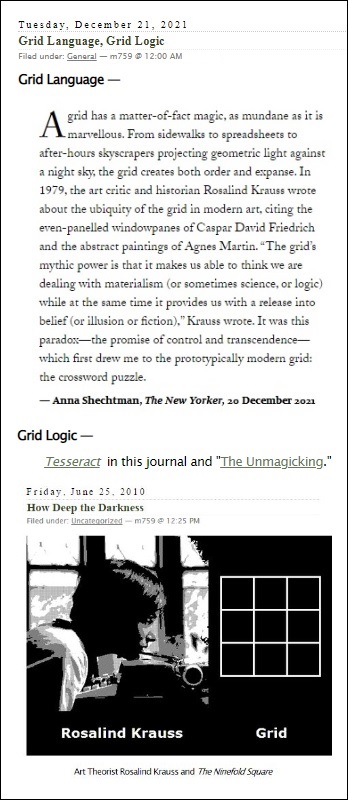











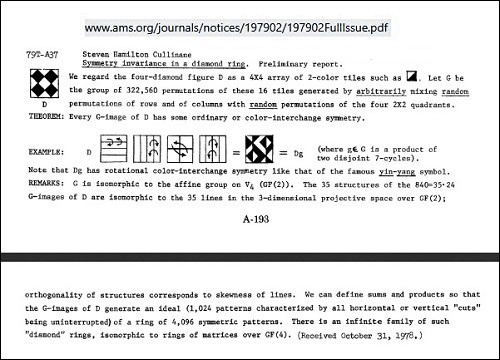






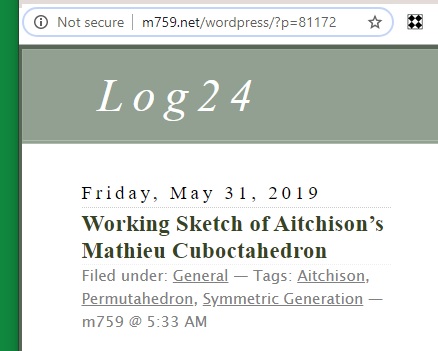





















































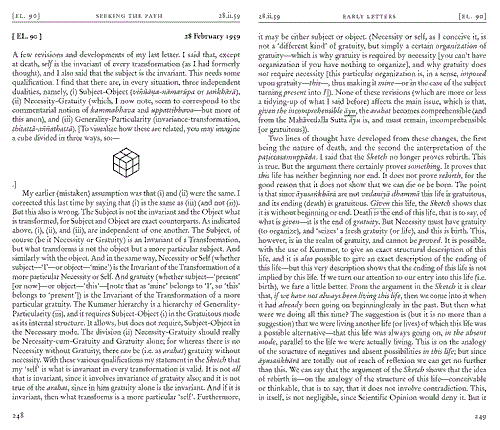










































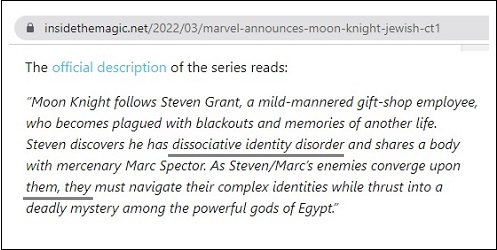


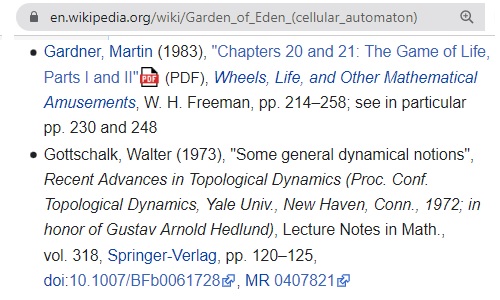





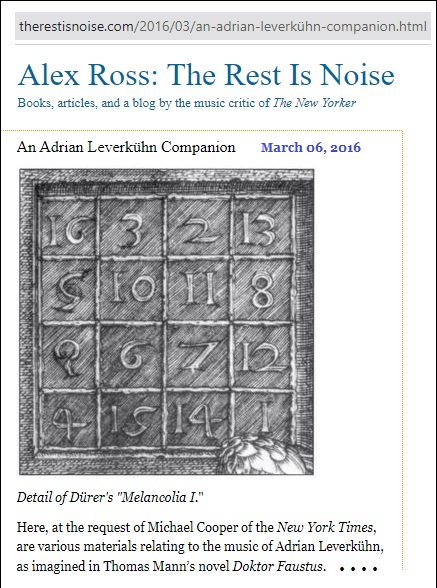





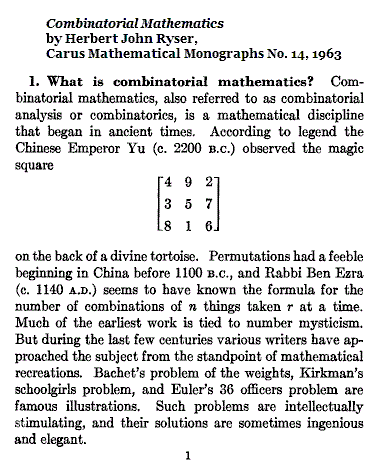

.jpg)





